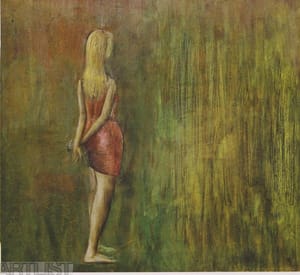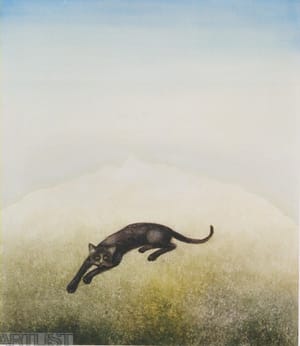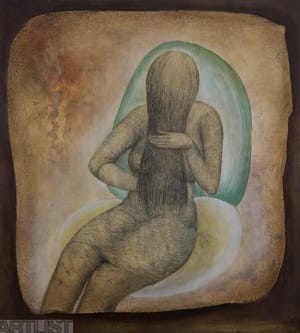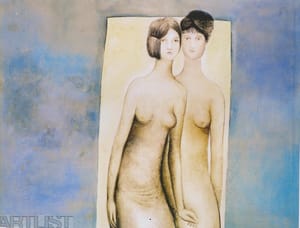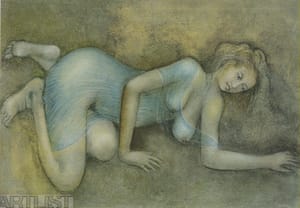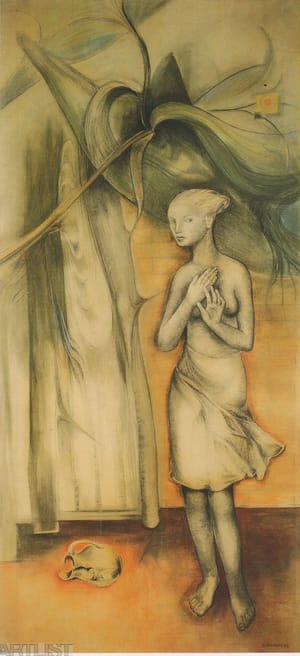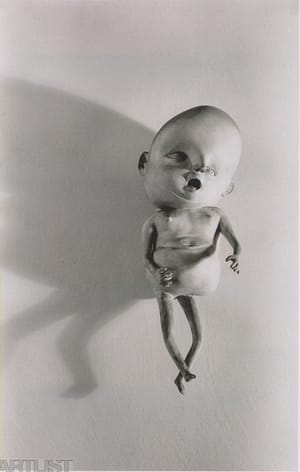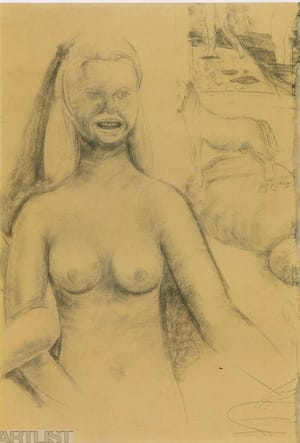- First Name
- Stanislav
- Surname
- Podhrázský
- Born
- 1920
- Birth place
- Pejhov u Jindřichova Hradce
- Place of work
- Praha
- Died
- 1999
- CSU Library
- ↳ Find in the catalogue
About artist
Stanislav Podhrázský was a painter, draftsman, sculptor and restorer. He was trained as a painter and decorator and left for Prague aged fifteen. Here he completed a three-year course at the State Central School of the Housing Industry. He joined the Academy of Arts, Architecture and Design immediately after the war, as did his peers Miloslav Chlupáč and Zbyněk Sekal.
At the end of the 1940s his work was highly influenced by surrealism, which had been introduced to the František Tichý studio, where Podhrázský studied, by Mikuláš Medek. As the artist himself said: “[surrealism] for me was the most acceptable programme. I was most drawn to the freedom of thought that surrealism offered.”[1] At this time in his life Podhrázský was involved mainly in sculpture, and his works occupy a unique position in Czech surrealism (Jeníček, 1949; Jeptiška / The Nun, 1949).
The sculpture Nohy / Legs (1947) is known mainly from the cycle of arranged photographs by Emila Medková taken at the window of Podhrázský’s studio. The painting Imaginace strachu – Kočka / The Imagination of Fear – Cat from 1949, the central motif of which is a hand, which the artist was obsessed with around this time, is often cited as capturing the zeitgeist after the onset of the communist regime. This period was brought to a close by psychological problems the artist suffered and his voluntary hospitalisation, as a consequence of which he barely created anything in the first half of the 1950s. He left art school without graduating in 1950 and made a living doing restoration work (e.g. on the Fričkovice Chateau and schools in Strakonice and Klatovy).
In 1955 he returned to art and focused on the theme of a young girl with a symbol in the form of a broken jug (Dívka u stolu / Girl at the Table, 1956).
In 1957 he became a member of the May 57 group, the first such group formed after the ban on such gatherings was lifted, and participated in three exhibitions with it (in 1957, 1958 and 1964).
Two important oil paintings from the same year (Neděle / Sunday; Milenci / Lovers) opened a “programme of magic civilism” in his work, in which he abandoned the moment of internal ecstasy and turned to seemingly quiet subject matter.[2] At this time his work was dominated by drawing, especially charcoal, and the female nude. As Marie Klimešová has observed, his drawings can be divided into two groups: one is based on the artist’s previous experience of surrealism and features deformations of physiognomy and a tense, challenging corporeality that takes on an archetypal character as a symbol of fertility and desire, while the second is lyrical in expression and underscores a girlish grace and dreamy emotion.[3]
Again the motif of a jug traditionally associated with the symbolism of a girl’s virginity appears frequently. The theme of a delicate girlish beauty also dominates Podhrázský’s canvases (Sestry / Sisters, 1963; Dívka s dlouhými vlasy / Girl with Long Hair, 1967).
From the 1960s onwards Podhrázský’s figures were placed within landscape, an uncomplicated, symbolic, flat landscape limited to implied elevations (Milenci / Lovers, 1969) or an inert, coloured background (Skupina dívek / Group of Girls, 1969; Koupání / Swimming, 1971). The human figure is sometimes represented by an animal, often dogs (Psí cesta / A Dog’s Journey, 1970), horses (Modří koně / Blue Horses, 1983), birds (Ptáček na skořápce / Bird on an Eggshell, 1980), and predators, either cats or lions (Stín kočky / Shadow of a Cat, 1981; Boj / Struggle, 1988).
Within the context of Czech art Podhrázský is a solitary individual, determined mainly by his uncompromising focus on the figure and his distinctive imagination. His work did not undergo any great changes: from his early artefacts to his late works we encounter the same subject matter, namely the female nude, lovers, and figures set within a landscape. Scenes captured within a kind of timelessness complete his idiosyncratic iconography: a jug, boat, hair, an animal... His paintings and drawings are imbued with eroticism. Podhrázský sought inspiration in the Italian renaissance and mannerism. The building blocks he used are light and colour, though the range of colour is limited, with several paintings appearing almost monochrome.
Podhrázský was also a key figure in the restoration work carried out at Litomyšl Castle, which took place over several stages during the 1970s and 80s. His biggest contribution was the restoration of the monumental figural sgraffito.
In 1983, four of his drawings were acquired on the suggestion of Jana Claverie and František Šmejkal for the collection of the Centre Georges Pompidou. The largest retrospective of his work to date was organised by the Prague City Gallery in 2013 and curated by Marie Klimešová).[1] EIDERNOVÁ-KOUBOVÁ, Vladimíra. “Toužil jsem hlavně to umět. Rozhovor se Stanislavem Podhrázským”, Revolver Revue, 1993, no. 24, p. 54.
[2] KLIMEŠOVÁ, Marie. Stanislav Podhrázský, Praha: Arbor vitae, 2013, p. 97.
- Author of the annotation
- Kateřina Štroblová / Rathouská
- Published
- 2018
CV
Studium: 1945–1950 Vysoká škola uměleckoprůmyslová, Praha (u Františka Tichého) 1942– Státní ústřední škola bytového průmyslu v Praze
- Member of art groups included in ARTLIST.
Exhibitions
- Solo exhibitions
-
2015
Stanislav Podhrázský: Dvě dívky, 1956, Muzeum východních Čech v Hradci Králové, Hradec Králové
2013–2014
Stanislav Podhrázský: Neklidná krása, Dům U Kamenného zvonu, Praha
2010–2011
Stanislav Podhrázský: Podhrázský, Galerie Zdeněk Sklenář, Praha
2001
Stanislav Podhrázský: Milenci (Vzpomínkové odpoledne), Galerie Zdeněk Sklenář, Praha
Stanislav Podhrázský: 1920–1999, Zámek Litomyšl, Litomyšl
Stanislav Podhrázský: 1920–1999, České muzeum výtvarných umění, Praha
1995
Stanislav Podhrázský, Státní galerie výtvarného umění v Náchodě, Náchod
Stanislav Podhrázský, Galerie moderního umění v Roudnici nad Labem, Roudnice nad Labem
1991
Stanislav Podhrázský: Výběr z díla, Galerie Nová síň, Praha
1982
Stanislav Podhrázský: Obrazy - kresby, Městské kulturní středisko, Dobříš
1972–1973
Stanislav Podhrázský, Severočeská galerie výtvarného umění v Litoměřicích, Litoměřice
1971
Stanislav Podhrázský: Obrazy, kresby, Galerie umění Karlovy Vary, Karlovy Vary
1969
Stanislav Podhrázský: Obrazy a kresby, Galerie Václava Špály, Praha
Stanislav Podhrázský, Krajská galerie, Hradec Králové
Stanislav Podhrázský, Galerie výtvarného umění v Chebu, Cheb
1966
Stanislav Podhrázský, Galerie bratří Čapků, Praha
Stanislav Podhrázský: Obrazy 1962 - 66, Galerie Jaroslava Krále, Brno
- Group exhibitions not included in ARTLIST.
-
2017
Příliš mnoho zubů - České a slovenské umění šedesátých let ze sbírky Galerie Zlatá husa a Musea Kampa, Museum Kampa - Nadace Jana a Medy Mládkových, Praha
České poválečné umění 1956 – 1996, Galerie Moderna, Praha
2016–2017
Kunst in Europa 1945 – 1968. Die Zukunft im Blick, Zentrum für Kunst und Medientechnologie, Karlsruhe (DE)
2016
Milý Ježíšku, Galerie Zdeněk Sklenář, Litomyšl
2015–2016
Příběh Alšovy jihočeské galerie: Od gotiky po současnost, Galerie Smečky, Praha
2015
České umění ze sbírky Galerie výtvarného umění v Náchodě (II. část - plastika), Galerie výtvarného umění v Náchodě, Náchod
Schránka pro ducha, Galerie moderního umění v Roudnici nad Labem, Roudnice nad Labem
Má vlast: Pocta české krajinomalbě, Jízdárna Pražského hradu, Praha
2014–2017
Stavy mysli / Za obrazem, Galerie Středočeského kraje (GASK), Kutná Hora
2013
Absolutní krása, Galerie Moderna, Praha
2012
Aukce moderního a současného umění, předaukční výstava, Galerie Maldoror, Praha
Aukce moderního a současného umění, předaukční výstava, Augustine Hotel, Praha
2011–2012
Údolí neklidu - Surrealismus a jeho vlivy, Galerie moderního umění v Hradci Králové, Hradec Králové
2010
Roky ve dnech. České umění 1945 – 1957, Městská knihovna Praha, Praha
2009–2010
...ze sbírky II. Člověk ve 20. století, Galerie umění Karlovy Vary, Karlovy Vary
2009
České a slovenské umění 60. let 20. století, Dům umění, Ostrava
2008–2009
České a slovenské umění 60. let 20. století, Dům umění, Zlín
2008
Pohledy do sbírek Severočeské galerie výtvarného umění v Litoměřicích, Severočeská galerie výtvarného umění v Litoměřicích, Litoměřice
České a slovenské výtvarné umenie šesťdesiatych rokov 20. storočia, Galéria Miloša Alexandra Bazovského v Trenčíne, Trenčín (SK)
České a slovenské výtvarné umenie šesťdesiatych rokov 20. storočia, Galéria Petra Michala Bohúňa, Liptovský Mikuláš (SK)
2007–2008
České umění XX. století: 1970 – 2007, Alšova jihočeská galerie v Hluboké nad Vltavou, Hluboká nad Vltavou
2007
Od sochy ... České sochařství 2. poloviny 20. století ze sbírek Galerie Klatovy / Klenová, Galerie U
Bílého jednorožce, Klatovy
Skupina Máj 57, Pražský hrad, Císařská konírna, Praha
2006
Šedesátá / The sixties ze sbírky Galerie Zlatá husa v Praze, Galerie umění Karlovy Vary, Karlovy Vary
České umění XX. století: 1940 – 1970, Alšova jihočeská galerie v Hluboké nad Vltavou, Hluboká nad Vltavou
2005
Opojná plasticita a ztělesnění duchovního světa, Figura v českém sochařství 20. století, Mánes, Praha
Kresba a grafika 60. let, Wortnerův dům Alšovy jihočeské galerie, České Budějovice
2004
Česká krajinomalba ze sbírek Galerie výtvarného umění v Chebu, Galerie výtvarného umění v Chebu, Cheb
Z národní klasiky, Galerie Zdeněk Sklenář, Litomyšl
Šedesátá / The sixties ze sbírky Galerie Zlatá husa v Praze, Dům umění města Brna, Brno
2002
Erotika, Galerie Jiřího a Běly Kolářových, Praha
Černá a bílá, Muzeum v Bruntále, Bruntál
Černá a bílá, Městské muzeum a galerie, Svitavy
Černá a bílá, Galerie Šternberk, Šternberk
Poezie magického realismu, Galerie moderního umění v Roudnici nad Labem, Roudnice nad Labem
2001–2002
Jiří Kolář sběratel / Jiří Kolář the Collector, Veletržní palác, Praha
2001
Bilance II. Obrazy a sochy, Galerie umění Karlovy Vary, Karlovy Vary
2000–2001
100 + 1 uměleckých děl z dvacátého století / 100 + 1 Art Works of the Twentieth Century, Dům U Černé Matky Boží, Praha
2000
Umění zrychleného času. Česká výtvarná scéna 1958 – 1968, Galerie výtvarného umění v Chebu, Cheb Konec světa? / The End of the World?, Palác Kinských, Praha
Moderní česká kresba, Galerie Vltavín, Masarykovo nábřeží, Praha
1999
Umění zrychleného času. Česká výtvarná scéna 1958 – 1968, Praha
1998
Podoby fantaskna v českém výtvarném umění 20. století, Alšova jihočeská galerie v Hluboké nad Vltavou, Hluboká nad Vltavou
1997–1998
Proměny krajiny v českém malířství 20. století, Veletržní palác, Praha
1997
Umění zastaveného času / Art when time stood still: Česká výtvarná scéna 1969 – 1985, Brno
Umění zastaveného času / Art when time stood still: Česká výtvarná scéna 1969 – 1985, Galerie výtvarného umění v Chebu, Cheb
1996
Setkání / Encounters. Stanislav Podhrázský, Zdeněk Palcr, Galerie U Bílého jednorožce, Klatovy
V prostoru 20. století. České umění ze sbírky Galerie hlavního města Prahy, Městská knihovna Praha
Eine Promenade der Romantiker, Stadtmuseum Göhre, Jena (DE)
Umění zastaveného času / Art when time stood still: Česká výtvarná scéna 1969 – 1985, Praha
Zpřítomnění, Přírůstky galerie z let 1987 – 1994, Galerie Klatovy / Klenová, Janovice nad Úhlavou
1994
Z českého výtvarného umění, Zámek Litomyšl, Litomyšl
Ohniska znovuzrození, Městská knihovna Praha, Praha
1993–94 Záznam nejrozmanitějších faktorů… České malířství 2. poloviny 20. století ze sbírek státních galerií, Jízdárna Pražského hradu, Praha
1992
Sztuka czeska i słowacka XX. w., Muzeum Narodowe we Wrocławiu, Wrocław (PL)
České výtvarné umění 1960 – 1990, Středočeská galerie, výstavní síně, Praha
1991
České malířství a sochařství 2. poloviny 20. století ze sbírek Alšovy jihočeské galerie, Alšova jihočeská galerie v Hluboké nad Vltavou
Šedá cihla 78/1991, Galerie U Bílého jednorožce, Klatovy
Šedá cihla 78/1991, Dům umění v Opavě, Opava
1990
Výtvarné tendence, Středočeská galerie, Praha
Výběr z fondů galerie. Šedesátá léta, Galerie umění Karlovy Vary, Karlovy Vary
1989
Z nových zisků Národní galerie v Praze (1987 – 1988), Národní galerie v Praze, Praha
Restaurátorské umění 1948-1988, Mánes, Praha
1988
České zátiší 20. století, Alšova jihočeská galerie v Hluboké nad Vltavou
1986–87
České umění 20. století, Alšova jihočeská galerie v Hluboké nad Vltavou
1986
Václav Boštík, Zdeněk Palcr, Stanislav Podhrázský, Olbram Zoubek, Galerie Josefa Matičky, Litomyšl
1985
Vyznání životu a míru. Přehlídka československého výtvarného umění k 40. výročí osvobození Československa Sovětskou armádou, Praha
Vyznání životu a míru. Přehlídka československého výtvarného umění k 40. výročí osvobození Československa Sovětskou armádou, Dom kultúry, Bratislava (SK)
1984
Wspołczesna sztuka czeska. Druga kolekcja Janiny Ojrzyńskiej, Galeria Bałucka, Łódź (PL)
Malba a plastika 20. století ze sbírek Galerie hlavního města Prahy, Severočeská galerie výtvarného umění v Litoměřicích, Litoměřice
Česká kresba 20. století ze sbírek Alšovy jihočeské galerie, Alšova jihočeská galerie v Hluboké nad Vltavou
Wspołczesna sztuka czeska. Kolekcja Janiny Ojrzyńskiej, Muzeum Narodowe we Wrocławiu, Wrocław (PL)
1983
Wspołczesna sztuka czeska. Kolekcja Janiny Ojrzyńskiej, Galeria Anny Wesołowskiej, Łódź (PL)
20 let Galerie hlavního města Prahy, Staroměstská radnice, Praha
Dessins tchèques du 20e siècle, Centre Georges Pompidou, Paříž (FR)
1981
České malířství a sochařství 1900 – 1980, Alšova jihočeská galerie v Hluboké nad Vltavou
1980
Výtvarní umělci k 35. výročí osvobození Československa Sovětskou armádou, Praha
Kresby, Zámek Rychnov nad Kněžnou, Rychnov nad Kněžnou
Zeitgenössische Kunst aus der Tschechoslowakei, Wessenberghaus, Konstanz (DE)
1979–1980
Česká portrétní malba 20. století, Dům pánů z Kunštátu, Brno
1979
České umění 1945/1975, Alšova jihočeská galerie v Hluboké nad Vltavou
1978
Pittura céca contemporanea, Palazzo del Monte, Padova (IT)
1977
České maliarstvo a sochárstvo 20. storočia - prírastky Galerie hl. města Prahy, Mirbachov palác, Bratislava (SK)
1976
Obrazy a plastiky ze sbírek Galerie hlavního města Prahy (Výběr z přírůstků 1970 – 1975, díl. II), Staroměstská radnice, Praha
1974
České malířství XX. století, Oblastní galerie v Liberci, Liberec
Přírůstky z let 1972 – 74, Galerie moderního umění v Roudnici nad Labem, Roudnice nad Labem
1973
Obrazy o lidech, Východočeská galerie v Pardubicích, Pardubice
1972
České umění 20. století z nové instalace sbírek GVU v Chebu, Galerie výtvarného umění v Chebu, Cheb
1970
Obrazy o lidech, Východočeská galerie v Pardubicích, Pardubice
Konfrontace I, Galerie Nova, Praha
1969
Obraz 69. Celostátní výstava současné malířské tvorby, Uměleckoprůmyslové muzeum, Brno
Tschechische Malerei des 20. Jahrhunderts, Ausstellungsräume Berlin 12, Berlín (DE)
Mai czsehszlovák képzömüvészet, Műcsarnok (Kunsthalle Budapest), Budapešť (HU)
1968
Nové tendence v tvorbě mladých českých výtvarníků: Obrazy, kresby, grafika, plastiky z šedesátých let, Východočeská galerie v Pardubicích, Pardubice
I. Triennale New Delhi, Dillí (IND)
Počátky generace, Galerie Václava Špály, Praha
Výtvarníci Špálovej galérie, Výstavná sieň ZSVU (Dostojevského rad), Bratislava (SK)
Věcné dialogy, Oblastní muzeum v Písku, Písek
Künstlergruppe arche mit 10 Malern aus Prag, Kunstkreis Hameln, Hameln (DE)
Künstlergruppe arche mit 10 Malern aus Prag, Fritz-Henßler-Haus, Dortmund (DE)
300 malířů, sochařů, grafiků 5 generací k 50 létům republiky, Praha
1967
Ze současné tvorby našich malířů (Obrazy z let 1957 - 1966), Východočeská galerie v Pardubicích, Pardubice
České umění XX. století ze sbírek Středočeské galerie, Dům umění města Brna, Brno
Mostra d´arte contemporanea cecoslovacca, Castello del Valentino, Turín (IT)
Půjčte si, kupte si, Galerie Václava Špály, Praha
České umění XX. století ze sbírek Středočeské galerie, Zámek Nelahozeves, Nelahozeves
Fantasijní aspekty současného českého umění, Oblastní galerie Vysočiny v Jihlavě, Jihlava
Socha a kresba, Mánes, Praha
Fantasijní aspekty současného českého umění, Galerie Václava Špály, Praha
1. pražský salon, Bruselský pavilon, Praha
Współczesna plastyka z Pragi, Galeria Sztuki BWA, Sopot (PL)
Obraz 67. Celostátní výstava současné malířské tvorby, Uměleckoprůmyslové muzeum, Brno
1966
Jarní výstava 1966, Mánes, Praha
Přírůstky do sbírek Východočeské galerie Pardubice v letech 1965-1966, Východočeská galerie v Pardubicích, Pardubice
Aktuální tendence českého umění. Obrazy, sochy, grafika, Praha
1965
Vª biennale internazionale d´arte contemporanea della Repubblica di San Marino, Palazzo Kursaal, San Marino
Historie a přítomnost montáže, objektů, asambláže a materiálového umění, Galerie Václava Špály, Praha
Małarstwo a rzeźba z Pragi, Kraków (PL)
1964
Tvůrčí skupina Máj, Galerie Nová síň, Praha
1962
Nejmenší kresby za nejnižší ceny, Malá galerie Československého spisovatele, Praha
1961
Tvůrčí skupina Máj, Poděbrady, Poděbrady
1960
Zdeněk Palcr, Stanislav Podhrázský, Alšova síň Umělecké besedy, Praha
1958–1959
Umění mladých výtvarníků Československa 1958. Obrazy a plastiky, Jízdárna Pražského hradu, Praha
1958
2. výstava Skupiny Máj 57, Palác Dunaj, Praha
Umění mladých výtvarníků Československa 1958. Obrazy a plastiky, Dům umění města Brna¨
1957
Mladé umění / Tvůrčí skupina Máj 57, Obecní dům (Reprezentační dům obce pražské), Praha
- Collections
- Národní galerie v Praze Moravská galerie v Brně Galerie Klatovy – Klenová Alšova jihočeská galerie v Hluboké nad Vltavou Galerie moderního umění v Hradci Králové Galerie moderního umění v Roudnici nad Labem Galerie Středočeského kraje Galerie umění Karlovy Vary Galerie výtvarného umění v Chebu Galerie Zlatá husa v Praze Městská galerie Litomyšl Muzeum umění Olomouc Východočeská galerie v Pardubicích Galerie hlavního města Prahy Museum Kampa – Nadace Jana a Medy Mládkových Soukromé sbírky
Monography
- Monography
KLIMEŠOVÁ, Marie. Stanislav Podhrázský. Praha: Arbor vitae, 2013. KŘENKOVÁ, Hana. Stanislav Podhrázský: otrokem tajemství. Diplomová práce na Filozofické fakultě Univerzity Karlovy v Praze, 2013. KŘÍŽ, Jan; ZEMANOVÁ, Helena. Stanislav Podhrázský 1920 – 1999: Muzeum a galerie Litomyšl 15.7.-30.9.2001, České muzeum výtvarných umění v Praze 31.10.-9.12.2001 (kat. výst.). Praha: České muzeum výtvarných umění, 2001. KŘÍŽ, Jan. Stanislav Podhrázský (kat. výst.). Karlovy Vary: Galerie umění, 1998. PODHRÁZSKÝ, Stanislav; PALCR, Zdeněk. Setkání (kat. výst.). Klatovy: Galerie Klatovy-Klenová, 1996. PODHRÁZSKÝ, Stanislav. Stanislav Podhrázský (kat. výst.). Náchod: Státní galerie, 1995. KŘÍŽ, Jan. Stanislav Podhrázský: výběr z díla (kat. výst.). Praha: Nová síň, 1991. EIDERNOVÁ, Vladimíra; ČERNÁ, Marie. Stanislav Podhrázský: Obrazy - kresby (kat. výst.). Dobříš: Městské kulturní středisko, 1982. ZEMINA, Jaromír. Stanislav Podhrázský (kat. výst.). Litoměřice: Galerie výtvarného umění, 1972. MRÁZ, Bohumír. Stanislav Podhrázský: Obrazy, kresby (kat. výst.). Karlovy Vary: Galerie umění, 1971. ZEMINA, Jaromír. Stanislav Podhrázský (kat. výst.). Praha: Galerie Václava Špály, 1969. KONEČNÁ, Alena. Stanislav Podhrázský: Obrazy 1962 – 66 (kat. výst.). Brno: Galerie Jaroslava Krále, 1966. KŘÍŽ, Jan. Stanislav Podhrázský (kat. výst.). Praha: Galerie bratří Čapků, 1966. CHLUPÁČ, Miloslav. Stanislav Podhrázský, Zdeněk Palcr (kat. výst.). Praha: Alšova síň umělecké besedy, 1960.
- Articles
ŠÍDA, Jan. Výtvarník Stanislav Podhrázský miluje kočky, štíhlé nohy a džbány. In: novinky.cz [online]. 2.1.2014 [cit. 28. 1. 2018]. Dostupné z: https://www.novinky.cz/kultura/323340-recenze-vytvarnik-stanislav-podhrazsky-miluje-kocky-stihle-nohy-a-dzbany.html. LEDVINA, Josef. Solitér: k výstavě Stanislava Podhrázského. Art&Antiques, 2013, č. 12/1, s. 14-19, ISSN 1213-8398. VÁCHOVÁ, Lucie. Neklidná krása. Ateliér, 2013, č. 25-26, s. 1, ISSN 1210-5236. ŠETLÍK, Jiří. Výběr z díla Stanislava Podhrázského. Ateliér, 2011, č. 2, s. 3, ISSN 1210-5236. MACHALICKÝ, Jiří. Socha kabátu byla provokace. Lidové noviny, 2010, č. 296, s. 9, ISSN 0862-5921. HOROVÁ, Anděla. Rajská zahrada snu a tichého šílení. Ateliér, 2002, č. 2, s. 7, ISSN 1210-5236. WAGNER, Radan. Rebel Podrhrázský byl lyrikem. Večerník Praha, 2001, č. 275, s. 18, ISSN 1210-1117. HŮLA, Jiří. Ženská krása jaké stálá malířova jistota. Lidové noviny, 2001, č. 224, s. 16, ISSN 0862-5921. KUČERA, Leoš. Litomyšl mapuje Podhrázského. MF Dnes – Kraj hradecký Dnes, 2001, č. 167, s. 3, ISSN 1210-1168. ZEMINA, Jaromír. Hrst vzpomínek na Stanislava Podhrázského. Kritická příloha Revolver Revue, 1999, č. 15, s. 12-24, ISSN 1211-118X. HOROVÁ, Anděla. Skupina Máj 57, Dydek Ladislav, Chlupáč Miloslav, Palcr Zdeněk, Podhrázský Stanislav. Ateliér, 1998, č. 14-15, s. 2, ISSN 1210-5236. CHLUPÁČ, Miloslav. Zdeněk Palcr – Stanislav Podhrázský (Z vernisáže). Ateliér, 1996, č. 8, s. 4, ISSN 1210-5236. JANATA, Michal. Dva hlasy z ticha odloučení. Český týdeník, 1995, č. 118, s. 10. ISSN 1211-0302. (mik). Podhrázského snová realita. Dnešní Litoměřicko, 1995, č. 179, s. 9, ISSN 1210-6291. VANČA, Jaroslav. Podhrázského sen o duši nahých žen v roudnické galerii. Práce, 1995, č. 175, s. 9, ISSN 0231-6374. HLAVÁČKOVÁ, Marie. Stanislav Podhrázský v roudnické galerii. Severočeský regionální deník, 1995, č. 181, s. 16. (aku). Láska je umělcům věčným tématem: Stanislav Podhrázský vystavuje obrazy, kresby, sochy. Hradecké noviny, 1995, č. 93, s. 6, ISSN 1210-602X. PÁNKOVÁ, Marcela. Generacemi napříč. Ateliér, 1994, č. 2, s. 16, ISSN 1210-5236. KOUBOVÁ, Vladimíra. Toužil jsem hlavně to umět (rozhovor se Stanislavem Podhrázským). Revolver revue, 1993, č. 24, s. 52 – 84. ŠABOVIČOVÁ, Irena. Eros a sen. Playboy, 1993, č. 6, s. 22-23, ISSN 0862-9374. ŠETLÍK, Jiří. Šedá cihla 78/1991. Ateliér, 1991, č. 17, s. 8, ISSN 1210-5236. ŠABOVIČOVÁ, Irena. Tajemství průzračnosti. Svobodné slovo, 1991, č. 47, s. 5, ISSN 0231-732X. KOUBOVÁ, Vladimíra. Radost nezáměrnosti. Ateliér, 1991, č. 3, s. 1, ISSN 1210-5236. MILER, Karel. Dědic surrealismu. Lidové noviny, 1991, č. 32, s. 8. ISSN 0862-5921. LAMAČ, Miroslav. České zátiší na Hluboké. Ateliér, 1988, č. 6, s. 1, ISSN 1210-5236.
